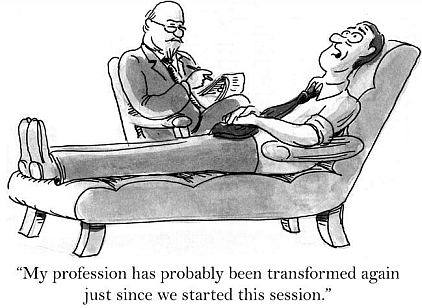As we all know – change happens whether we like it or not:
HOW we deal with it can be one of the easiest solutions on offer, yet it can also be one of the most challenging with which to grapple in practice.
Instead of much lip service as to WHY we should change, this post presents some poking thoughts about WHAT sort of changes are evident, by drawing from personal client case studies, ongoing research, and social media trends.
Some 15-20 years ago, our Organisational Psychology profession had fairly stock standard ways of operation, be it involving selection or placement or career advancement or transition etc. Most clients accepted and understood the process insofar as it had good scientific backing (the best did follow-up validations to demonstrate the relevance of the process), and ideally was performed by trained professionals who had years of proven experience – the proof was in the pudding and most clients were quite happy with the usefulness of the process as compared to those without the proper training who were not generally able to provide the same accuracy of outcomes – studies such as this one were seminal : Sara L. Rynes, Amy E. Colbert, and Kenneth G. Brown (2002), Human Resource Management (Summer 2002, Vol. 41, No. 2, Pp. 149–174), HR Professionals’ Beliefs About Effective Human Resource Practices: Correspondence Between Research And Practice, Wiley Periodicals, Inc., DOI: 10.1002/hrm.10029.
Things are different now. With the advancement of on-line technology, the speed with which things can be done, procedural adherence, proctured diligence and standardised environmental conditions have all but fallen to the wayside having bowed out to, among other things, three kings – SPeed, Accessibility and Turnaround – think of it as “SPAT” out info.
Well – did we really expect anything to be different? We all know that it’s become a fast paced world and those who draw the quickest generally get rewarded. To be fair, there are complicated dynamics underpinning this speed model in the modern environment – and in fact there are good reasons why speed over end content does deliver first place in many organisations. Of course, the industries which rely on safety may beat to a different drum. In short, the end game is around a much narrower set of parameters – why? – because in so many circumstances it CAN be, and it doesn’t change bottom lines – in fact it can enhance them. And a new proposed staffing model is born thus:
Perception is EVERYTHING:
This is without doubt the fourth king: PERCEPTION. You are not being judged on what you know anymore, and many times, not even by what you explicitly achieve. No – what is more important is what you are perceived to be doing, what you can make others believe, and how you can position yourself to be SEEN to be accountable when it counts.
It’s one of the reasons why staffing and selecting from a pool of applicants has never been more difficult, and never been easier. More difficult because your good old key competency model could now be rendered worthless, while more and more people can do a job for reasons which before would never have been considered. To add to the jigsaw, more and more people are capable of doing a job because at the end of the day, the requirement is less and less dependent on crystallised knowledge or “horsepower intelligence”, and more and more on emotional intelli-gising and influen-cising smarts, i.e., using old fashioned EI and Persuasive “techniques”, but for more minacious or … iffy means. Welcome anybody who has these new age skills – the business world has just become your oyster.
For the non-believers, just take a look at the age of incoming CEO’s vs 20 years ago – keep in mind that life expectancies are longer these days, not shorter. This stuff matters: http://qz.com/166317/why-it-makes-sense-to-pay-beautiful-ceos-more/. Take a look at the type of work CEO’s are being paid to do now vs 25 years ago. CEO’s are paid to influence others into making the big decisions but what’s of greater interest is the extent to which they are engineering WHAT outcomes?
The work is being done lower down the food chain, and these days the real content is distantly housed deep inside IT programs while somewhere up the line someone is doing modern work and getting paid head-spinning wages for it. And the winner is? Well – stand in line and good luck because high chance you’re now behind a Watusi dancing genius whose hand is held high and leading alright – in the claim game. Hail the new leader!
That’s something new.
Contributor: Richard Want, Partner, Kendall Want Associates
*Cartoon credit: funny-pictures.picphotos.net

